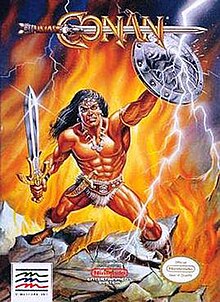Conan: The Mysteries of Time
| Conan | |
|---|---|
 Cover art (NES) | |
| Developer(s) | Eastridge Technology[1] |
| Publisher(s) | Mindscape |
| Composer(s) | Nick Eastridge |
| Platform(s) | NES |
| Release |
|
| Genre(s) | Action |
| Mode(s) | Single-player |
Conan (also known as Conan: The Mysteries of Time) is a side-scrolling action video game for the Nintendo Entertainment System released in 1991. It was developed by Eastridge Technology and published by Mindscape. While it features the Conan the Barbarian character, it is a simple adaptation of a computer game called Myth: History in the Making, which was developed by System 3.[2]
Gameplay
[edit]One night, the titular Conan, who seeks the throne of Aquilonia, is informed of a legend by a mysterious old man named Nemonios popping out of a campfire; there are Four Urns of the kingdom's Early Kings have vanished from their location in the Crypt of Cahalla, and that whoever returns these Urns shall gain the throne.[3]
Conan is an action-adventure video game that lasts six levels:[4] the Catacombs of Belveras,[5] the Ruins of Ry-leeh in Brythunia,[5] Kordavo at the "mouth" of the Black River,[6] the Forests of Asgard,[6] the Sky Castle of Vanaheim, and the Tombs of Zamboula, the location of the four Urns.[6] It is also a puzzle game, as the player has to figure out the hidden locations of special weapons to complete bosses;[4][7] info about the items are in the game's instruction manual, except for the location.[7]
Reception
[edit]Critical reviews for Conan were mixed-to-negative; Skyler Miller of AllGame called it one of the worst NES titles ever,[8] the author of Video Game Bible, 1985–2002, Andy Slaven, labeled it "platform gaming at its worst,"[10] and Game Players journalist Jeff Lundrigan described it as an interesting "combat puzzle" gameplay idea marred by poor execution.[7]
The difficulty was frequently criticized, with reviewers claiming that it's near impossible to get past the first level[9][8] and beat the game without cheat codes.[2] Lundrigan noted that while the character jumps in the air, his movement stops when hit by an enemy, leading to instant kills as a result of falling in bottomless pits.[7] Brett Weiss wrote the player had to work with "pitiful, sluggish attacks (including short-range punches, limp swordsmanship, and hard-to-execute jump kicks)."[2]
Reviews, even a positive one from GamePro also attributed the difficulty to the awkward controls, criticizing decisions of pressing down to jump[9][8][7] and having to push both an A-or-B button and the D-pad to perform movements like ducking.[4] The backgrounds were also dismissed as bland.[9][8]
Notes
[edit]References
[edit]Citations
[edit]- ^ https://vgmpf.com/Wiki/index.php/Conan_(NES) [bare URL]
- ^ a b c Weiss, Brett (2012). Classic Home Video Games, 1985-1988: A Complete Reference Guide. McFarland. ISBN 9781476601410. Retrieved September 16, 2020.
- ^ Instruction manual 1990, pp. 5–9.
- ^ a b c d The Missing Link (August 1991). "Conan". GamePro. No. 25. p. 20.
- ^ a b Instruction manual 1990, p. 10.
- ^ a b c Instruction manual 1990, p. 11.
- ^ a b c d e Lundrigan, Jeff (July 1991). "Conan". Game Players. No. 25. p. 79.
- ^ a b c d e Miller, Skyler. "Conan". AllGame. Archived from the original on December 12, 2014. Retrieved October 20, 2017.
- ^ a b c d "RETRO REVIEW: Conan – The Mysteries of Time". Exposed. August 19, 2015. Retrieved September 14, 2020.
- ^ Slaven, Andy (2002). Video Game Bible, 1985-2002. Trafford. p. 100. ISBN 9781553697312. Retrieved September 16, 2020.
Bibliography
[edit]- Conan instruction manual. Mindscape. 1990. pp. 1–19.
